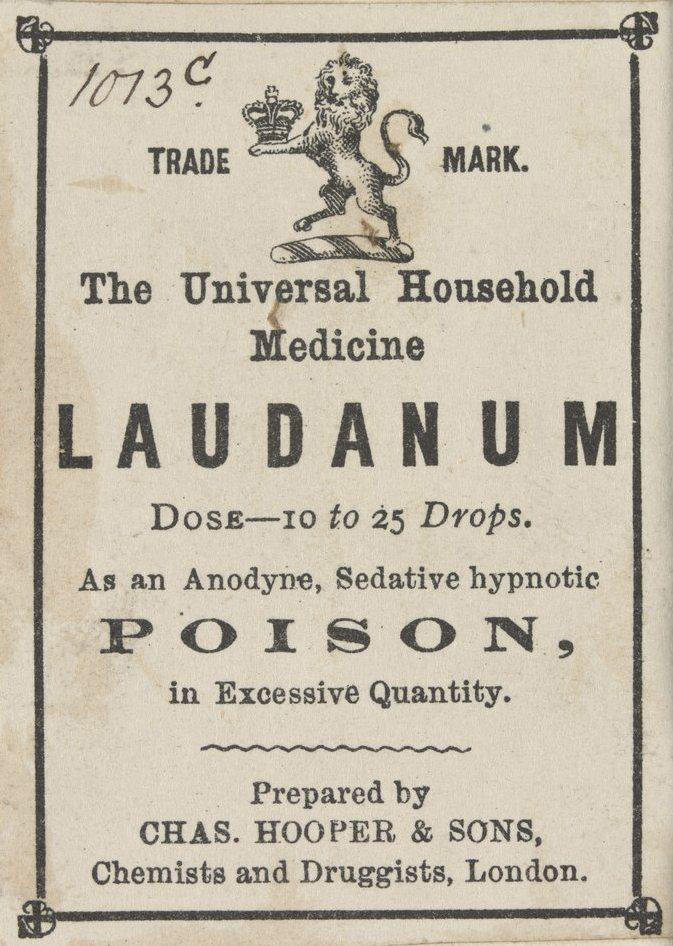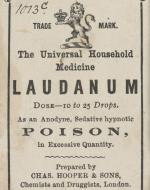Created by Raelene Naegle on Wed, 10/05/2022 - 22:29
Description:
The First Drug Discovered
Derived from the opium poppy (Papaver somniferum), opium has been recorded as the first discovered drug and has been used in medical practices for centuries. In his book Opium: A History, Martin Booth traces the historical uses of opium in medicine. He notes, “The plant has a dubious history. Some horticulturists consider it evolved naturally, but there are others who claim it is a cultivor developed by century upon century of human cultivation” (1). The history of opium can be followed from Mesopotamia in the 4th millennium BCE, to where it is picked up as a form of Western medical practices in the 19th century. From here we can see the ways in which opium has been used, cultivated and marketed, the history progressively growing darker and darker as more light is shed on the drug entering the Victorian era—both as a culture and a practice.
Victorians and Opium Culture
Like most industries during the Victorian era, there was a boom in the harvesting and selling of opium. It was advertised as an ingredient in countless medicines on the market, claiming the ability to treat an array of ailments. Naturally, the drug was very lucrative during this time. Booth explains the sordid market, “The area under poppy cultivation in 1870 was 560,608 acres…The total opium revenue came to £7,657, 213” (10). To put this into perspective, this converts to nearly $900 million today. We can see the effect of this massive industry on Victorian society encompassed in the attached advertisement for laudanum. Opium and other opium-based products—such as laudanum—were widely accessible by the public, marketed with a wide range of dosages. While this was a highly sought out product, Victorian’s also became aware of the dangerous nature of opium as we can note in the warning of possible poisoning.
The availably and lack of regulation significantly impacted the Victorian views on the drug and the ways in which it was integrated into the culture. British Historian Virginia Berridge notes, “Addiction was not seen as a pressing social problem in England” (437). Although, she continues to note how the drug entering the narrative within taboo spaces, among seemingly conservative Victorian England was a major marker in public perception. Berridge explains how a cultural shift happened among the views of opium when a cultural narrative centered around those marginalized began to form. She notes the intentional use of opium in suicide and potential criminal use as some sailors made claims prostitutes drugged them with opium in order to rob them—despite the latter having no foundational proof (445). While opium was a problem for Victorian’s from every walk of life, due to easy accessibility and lack of information on the drug, it was those of lower socioeconomic status that Victorian’s associated with the notice of opium being a problem. Author of The Making of Addiction: The 'Use and Abuse' of Opium in Nineteenth Century Britain, Louise Foxcroft tells us, “Further, it is argued that this ‘problem’ of opium use is a class issue, the ‘outcome of the class bias of Victorian society’, and it is thus understood as a ‘question of social control’” (5). We can see references to this in the modern association of opium dens, which were found in the East End slums of Victorian London, which marked the Victorian notice of the dark side of England as impacted by the drug. Here we can see the beginning of narratives shifting public perception, relations and Victorian Culture with opium, which becomes even more pressing as it enters the literary circuit.
Drug Use and Strange Literature
The mention of opium in literary works can be dated back as far as Homer’s Odyssey. However, notable representation appears in the ways in which opium and other drug use shows up in Victorian literature, especially in literature dealing with The Strange. In “Victorian Drug Use,” Dr. Andrzej Diniejko notes the relationship between creators and drug use, telling, “The recreational use of opiates was popular particularly with pre-Victorian and Victorian artists and writers” (2). The use of opium was not only referenced in the work of many writers, but used by the writers themselves. Booth elaborates on the history of this, noting opium use became especially impactful in the world of literature starting with the Romantics in the late 18th century and continuing to influence Victorian writers of the 19th (36). A turning point in opium reference in literature happens in 1821 with the publication of Thomas De Quincey’s autobiographical account with the drug, titled: Confessions of an English Opium Eater. Berridge explains that, “…although a major literary event and matter of much public discussion, [Quincey’s account] attracted a less concerned or anxious reaction than might have been supposed” (442). However, as this account grew in popularity, more light was shed on the darkness associated with opium. Even more so as the portrayal of opium appeared in fictional works, which became more and more common in literature of the 19th century especially among Victorian authors dealing with The Strange.
We can see how the normalization of opium use did shift as it became a focal point in literature dealing with The Strange, which is especially notable as we remember the prominence of conformity in the 19th century and a social aversion to strangeness, as the drug’s dubious nature was often highlighted. For Instance, Sir Arthur Conan Doyle’s The Man with the Twisted Lip, follows Sherlock Holmes as he investigates the murder of a man found above an opium den. Diniejko explains, “…in the 1860s, ‘Dark England’ with its opium dens in London's East End was described in popular press and books, various individuals and religious [organizations] began to campaign against unrestricted opium trafficking” (3). Literature was giving insight into the negative effects of the readily accessible drug. Opium use in novels involving strange and other mysterious themes and motifs does not stop here. Notable authors of the Victorian period who reference opium use include: Anne and Charlotte Brontë, Wilkie Collins, Brahm Stoker, Robert Louis Stevenson, Lewis Carroll, George Elliot, Thomas Hardy, Oscar Wilde, etc.
The work of these predominate authors shed more light on the detriment opium posed among Victorians. Foxcroft explains, “These experiences and trials of addiction were given graphic presentation via the culturally influenced medium of respectable Victorian fiction…” (39). When viewing Victorian literature, we can see the changing relationship with opium through the works as a means of reflected life of the time. In fact, literary criticism has pointed how addiction in strange Victorian fiction was reflective of Victorian society, stating, “…Jekyll’s addiction is revealed in the narrative as the aporia of Victorian society…throughout the novel, addiction is the inexplicable center of medical and legal discourse that attempt to rationally explain its origin, its progression and dangers ” (Comitini 113). From here we are able to see the influence narrative had on the shaping of opium’s history in 19th century society, making it a major component and tool in the reframing narrative, which highlighted the dangers of opium and addiction.
Opiate-related drug use remains a very pressing and prominent issue today and we can see traces of the current 21st century opioid epidemic traced back to the negligent accessibility of the not so distant past. However, the Victorian period remains incredibly relevant to the history of opium as it marks the start of regulation which we see begin to enter policy in 1912 with the Opium Law. The cultural shift, which brought on this necessary change beginning with the Victorian’s was influenced by the literature consumed during the period. The impact of showcasing opium use and abuse in popular forms of literature was a marking point for real change for public perception, which eventually made its way into regulated law.
Works Cited
Berridge, Virginia. “Victorian Opium Eating: Response to Opiate Use in Nineteenth-Century England.” Victorian Studies, vol. 21, no. 4, Indiana University Press, 1978, pp. 437-461, https://www.jstor.org/stable/3827593?seq=1&cid=pdf-+reference#references...
Booth, Marin. Opium: A History. St. Martin’s Press, New York, 1996, pp. 1-36. https://books.google.com/books?hl=en&lr=&id=HXGzAAAAQBAJ&oi=fnd&pg=PR1&d...
Comitini, Patricia. “The Strange Case of Addiction in Robert Louis Stevenson’s Strange Case of
Dr. Jekyll and Mr. Hyde.” Victorian Review, vol. 38, no. 1, The John Hopkins University Press, 2012, pp. 113-131. http://www.jstor.com/stable/23646857
Diniejko, Andrzej. “Victorian Drug Use.” The Victorian Web, 7 Mar. 2008, https://victorianweb.org/victorian/science/addiction/addiction2.html.
Foxcroft, Louise. The Making of Addiction: The 'Use and Abuse' of Opium in Nineteenth Century Britain. Burlington, VT: Ashgate Publishing Company,2007.https://www.google.com/books/edition/The_Making_of_Addiction/mKgsr7whoho...


